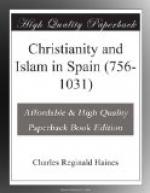[6] Dozy, iii. 262, 263.
[7] See article in the “Encyclop. Britann.”
[8] Al Makk., i. 198. De Gayangos, in a note, points out that this was a mistake: for Abdulmumen was grandfather of Yakub Almansur, and could not be the king meant here. He therefore reads, “Yakub, one of the Beni Abdulmumen.”
Side by side with, and in bitter hostility to, the earlier freethinkers lived the faquis or theologians. The Andalusians originally belonged to the Mohammedan sect of Al Auzai[1] (711-774), whose doctrines were brought into Spain by the Syrian Arabs of Damascus. But Hischem I., on coming to the throne, shewed his preference for the doctrines of Malik ibn Aus,[2] and contrived that they should supplant the dogmas of Al Auzai. It may be that Hischem I. only shewed a leaning towards Malik’s creed, without persuading others to conform to his views, but at all events the change was fully accomplished in the reign of his successor, Hakem I., by the instrumentality of Yahya ibn Yahya Al Seythi, Abu Merwan Abdulmalek ibn Habib,[3] and Abdallah Zeyad ibn Abdurrahman Allakhmi, three notable theologians of that reign. Yahya returned from a pilgrimage to the East in 827, and immediately took the lead in the opposition offered to Hakem I. on the ground of his being a lax Mussulman, but, in reality, because he would not give the faquis enough power in the State.[4]
In the reign of Mohammed (852) these faquis had become powerful enough to impeach the orthodoxy of a well-known devout Mussulman, Abu Abdurrahman ibn Mokhli, but the Sultan, with a wise discretion, as commendable as it was rare, declared that the distinctions of the Ulema were cavils, and that the expositions of the new traditionist “conveyed much useful instruction, and inculcated very laudable practices."[5]
Efforts were made from time to time to overthrow this priestly ascendency, as notably by Ghazali, the “Vivificator,” as he was called, “of religious knowledge.” This attempt failed, and the rebel against authority was excommunicated.[6] Yet the strictly oxthodox party did not succeed in arresting—to any appreciable extent—the progress of the decay which was threatening to attack even the distinctive features of the Mohammedan religion.[7] It is a slight indication of this, that the peculiar Moslem dress gradually began to be given up, and the turban was only worn by faquis,[8] and even they could not induce the people to return to a habit once thought of great importance.[9]
[1] Al Makk., i. 403. De Gayangos’ note.
[2] Died 780. Al Makk.,
i. 113, 343, ascribes the change to
Hakem I.; and an author quoted,
i. p. 403, ascribes it to
Abdurrahman I.
[3] Al Makk., ii. 123.
[4] Al Makk., i. 113, implies
the reverse of this. Dozy, ii. p.
59.
[5] Conde, i. 294.
[6] Dozy, iv. 255.
[7] In spite of Al Makkari’s statement, i. 112, where he says that all innovations and heretical practices were abhorred by the people. If the Khalif, he says, had countenanced any such, he would have been torn to pieces.
[8] Dozy, iii. 271.




